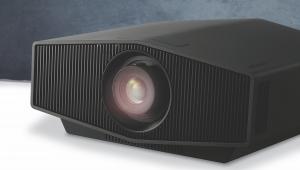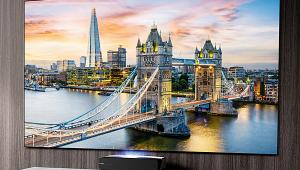Sony VPL-VW95ES review
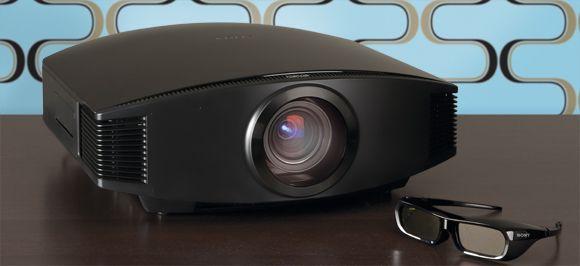
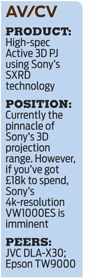 Sony made it pretty clear during HCC’s recent trip to Tokyo that it sees delivering uncompromising quality as the way to get its once-peerless reputation – and sales! – back. With this in mind, the crosstalk that hampered the brand’s first 3D projector, the VW90ES, needs to be made a thing of the past. Does the ‘sequel’ to the VW90ES, the VW95ES, back up this new brand philosophy?
Sony made it pretty clear during HCC’s recent trip to Tokyo that it sees delivering uncompromising quality as the way to get its once-peerless reputation – and sales! – back. With this in mind, the crosstalk that hampered the brand’s first 3D projector, the VW90ES, needs to be made a thing of the past. Does the ‘sequel’ to the VW90ES, the VW95ES, back up this new brand philosophy?
The VW95ES certainly looks like it means business. It’s big, heavy, clad in a luxurious high-gloss black finish, and possessed of a large, centrally mounted lens, around which the bodywork arches seductively to form a vaguely elliptical shape if viewed from the front.
It’s adequately connected, too, with its two 3D-capable v1.4 HDMIs, D-Sub PC jack, and custom installation-friendly LAN, RS-232 and 12V trigger ports. Personally I wouldn’t mind seeing a third HDMI starting to appear on premium projectors, but then I guess that relatively expensive models like this will be installed as part of a wider system that includes an AV receiver with HDMI switching.
In terms of other key specs, beyond the fact that it has Active 3D playback (with two pairs of spex included), there’s a promising amount of stuff to get your teeth into. One of the most significant developments is the introduction of the same Dynamic Lamp Control technology that did such an effective job of boosting 3D brightness levels with Sony’s entry-level 3D projector, the HW30. It works by boosting the light output when the shuttering mechanism in Sony’s glasses is open, and reducing it when the shutters are closed, thus making the 3D image look around 25 per cent brighter without using more power.
The VW95ES also employs a 240Hz driving system for its SXRD (Sony’s variation on LCoS) chipsets, a fact which experience suggests should prove handy in combatting Active 3D’s potential to suffer crosstalk ghosting noise.
The projector’s claimed dynamic contrast ratio of 150,000:1 is impressive, too, though a ‘mere’ 1,000 lumens of brightness makes me relieved that the projector has Dynamic Lamp Control onboard.
Straightforward setup

Setting the VW95ES up is likeably straightforward for such a sophisticated beast. For instance, the zoom and focus functions are adjustable via the remote control, and can be fine-tuned with excellent levels of precision. It’s got a decent amount of optical zoom (1.6x) to aid its placement in your room, too, and supports both horizontal and vertical image shifting.
As if all this wasn’t enough, the VW95ES also benefits from a picture position memory, via which you can set and store separate picture settings for 2.35:1/2.37:1 and standard 16:9-ratio viewing. Movie fans with CinemaScope projection screens will find this functionality very useful indeed – it’s a more practical and affordable solution than purchasing a separate anamorphic lens.
Many of the improvements Sony has brought to the VW95ES’s spec sheet compared with the VW90ES appear to have been introduced to boost its ‘headline’ 3D performance. But as usual, these same improvements also turn out to have a positive impact on the VW95ES’s 2D prowess. In fact, they’ve made its 2D pictures nothing short of outstanding, even by the usually high standards of £5,000 projectors.
The most exceptional enhancement compared with the VW90ES concerns the VW95ES’s rendering of dark scenes. While they were good on the VW90ES, they look simply stunning on the VW95ES – partly on account of the sheer depth of black level they can plummet, but also because of the levels of greyscale gradation and shadow detail on show. Notoriously tough dark shots, like the opening sequence of the final Harry Potter... film, look completely natural, with more or less every nuance of detail and colour tone shift rendered.
This is significant because it means the VW95ES shows that Sony’s SXRD technology is now capable of achieving a black level response in the same ballpark as that of JVC’s new D-ILA projectors.
Admittedly, this is only the case if you use the VW95ES’s ‘dynamic’ contrast mode, via the auto iris, whereas the black levels delivered by JVC’s technology are native, with no brightness-adjusting tricks necessary. But Sony’s latest iris mechanism is an improvement over previous versions in that it only very occasionally works too aggressively, making the image appear to flicker or look unstable.
With immaculate blacks underpinning its images, the VW95ES also delivers the most natural and rich colours yet seen from SXRD, resulting in a wide, endlessly subtle dynamic range.
The VW95ES also delivers the sharpest HD images I’ve seen with SXRD, partly as a result of some impressively clean motion handling – even without using any of the somewhat tricksy motion processing options the projector carries. This further boosts the subtlety of colour details to the extent that even 2D pictures look, well, 3D.
Talking of 3D, the VW95ES delivers a very marked improvement over the VW90ES with a selection of my favourite 3D Blu-ray discs. For starters, the VW95ES’s pictures suffer much less with crosstalk than those of its predecessor. Second, its 3D pictures look brighter.
However, while these improvements are both sufficiently substantial to make the VW95ES a consistently enjoyable 3D watch, the resulting images are still not quite as immaculate as I want for my £5,000. For while crosstalk is reduced, it’s still clearly discernible around the edges of some distant objects.
An adjustment has been provided within the VW95ES’s 3D settings that allows you to sacrifice brightness in return for reducing crosstalk. But even using my preferred ‘-1’ setting, there’s still a touch of crosstalk to be seen – despite the image being at this point so short of brightness that watching in anything other than a completely blacked out room is pretty much impossible.
A question of costWhat you have in the VW95ES, then, is an absolutely outstanding 2D projector and a good but not flawless 3D projector – and one that runs exceptionally quietly, too. Yet there are quality 3D PJs further down the price ladder, like Epson’s TW9000 and JVC’s DLA-X30, which deliver superb all-round performances. The VW95ES offers a bit more 2D punch and precision, but there’s nothing much in it where 3D is concerned.
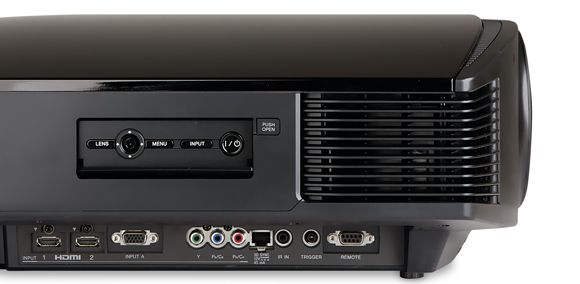
HCC VERDICT
Sony VPL-VW95ES
Price: £5,000 Approx
Highs: Well built and easy to use; runs almost silently in low lamp mode; 2D pictures are fantastic; 3D pictures are good
Lows: Still a little crosstalk with 3D; some rival models make it look expensive
Performance: 4/5
Design: 4/5
Features: 4/5
Overall: 4/5
Analysis
GUI: The VPL-VW95ES’s text-based menus are practical if a little dull
Power consumption: We measured an average consumption of 149W using the Cinema preset
Killer feature: The excellent chassis design does a brilliant job of venting heat from the 200W UHP lamp, so that the PJ runs whisper-quiet
Specifications
3D: yes Active shutter
Full HD: yes 1,920 x 1,080
Connections: 2 x HDMI; 1 x component; 1 x D-Sub PC input; 1 x 12V trigger; 1 x RS-232; 1 x LAN
Resolution: 1,920 x 1,080
Brightness: 1000 Lumens
Contrast ratio: 150,000:1
Dimensions: 470(w) x179.2(h) x 484.9(d)mm
Weight: 11kg
Features: 11 gamma modes; integrated 3D transmitter; 20dB fan noise; 9 picture presets; 240Hz SXRD drive system; auto iris with multiple settings; motorised lens with 1.6x zoom; vertical and horizontal image shifting; Motionflow processing; two pairs of 3D glasses included; colour management (RCP); IR In controls
 |
Home Cinema Choice #351 is on sale now, featuring: Samsung S95D flagship OLED TV; Ascendo loudspeakers; Pioneer VSA-LX805 AV receiver; UST projector roundup; 2024’s summer movies; Conan 4K; and more
|




